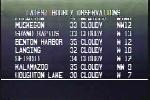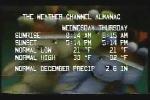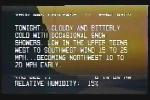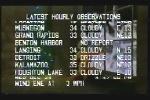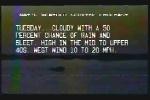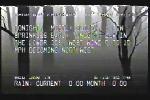WeatherSTAR 3000 and Jr. Timelines
Meet The WeatherSTAR 3000The WeatherSTAR began to debut in cable head ends nationwide upon TWC's first broadcast on May 2nd, 1982. Small percentages of cable companies carried TWC at first, and even smaller numbers installed this WeatherSTAR computer. When hooked up at these cable companies, the WeatherSTAR would dial-up to receive the latest weather conditions and forecasts for its local area. Then, when queued by TWC, would override TWC's viewing signal with its current conditions and forecast broadcast product, and transmit that through cable wires to its viewer's TV sets. The Local Forecast was born, and without that method of breaking away to display local information, TWC couldn't have been a success. The idea was perfect, the product however wasn't quite. The original WeatherSTAR suffered from garbled text issues. While receiving that data, the signal might have have endured some interference creating a mixed up output. Furthermore, although meeting with the FCC's regulations, the WeatherSTAR was outputting so much radiation that it would interfere with VHF Channel 2. In 1983, TWC had begun work to reduce its radiation interference with VHF Channel 2 and allowed each unit to receive its weather transmissions twice. If one transmission didn't match the other, they were both thrown out and the STAR would await the next update. By 1984 those changes had achieved completion, and the newly updated WeatherSTAR officially became the WeatherSTAR II. The WeatherSTAR II performed much more smoothly than the original WeatherSTAR. In 1985, the FCC began a plan to create more room for geosynchronous satellites. As a result, TWC needed to change the way their current STARs were receiving data. With some help from Wegener Communications and 2 million dollars later, TWC had once again upgraded the WeatherSTAR. By this time, it had become known as the WeatherSTAR III. BackgroundsDuring the fall of 1985 (and possibly earlier), The Weather Channel began experimenting with background images and animations for the WeatherSTAR 3000. It is not known why they did this, but one theory is that they wanted to appeal to their satellite subscribers. Until recently, satellite subscribers did not get a local forecast. When the segment ran, they would see something else. In the beginning, it was a pretty photo. Then it was blank blue screen. The assumption is that satellite viewers complained about this, so The Weather Channel came up with a unique idea to hopefully please everyone. Cable subscribers had their local forecast with a nice background, while satellite subscribers just saw the nice background. There were a surprisingly large number of backgrounds with a wide range of subjects and styles. From moving geometric shapes to still images and animations of animals. You'll probably find most or all of them to be quite primitive, but for the late 80s, this was cutting-edge stuff! Around the same time the backgrounds were introduced, new songs were selected for the local forecast. The playlist took on a decidedly more serene and upbeat mood. It's interesting to watch these local forecasts, in that it almost seems like the backgrounds were made to reflect the mood of the song. Unfortunately (or fortunately depending on your opinion of the practice) the graphical backgrounds didn't last long. The Weather Channel phased them out at the beginning of 1987. The last local forecast I have with a background image was on January 29, 1987. The Weather Channel said that viewers were complaining that they could not read the local forecast text. And after watching some of these local forecasts, it is easy to understand why. The white letters almost blend into the lighter backgrounds. It wasn't until around September 1, 1988 when an idea came to fruition that pleased both cable and satellite viewers. This is when the "Travel Cities Forecast" began appearing. This feature from the local forecast had a more basic banner and no crawl. And the list of cities scrolled over and over until the local forecast ended. If that wasn't exciting enough for satellite viewers, a new playlist was introduced for the national feed. This meant that satellite viewers would hear different music than cable viewers, as the WeatherSTAR 3000 playlist remained unchanged. The practice of showing satellite viewers the "Travel Cities Forecast" continued until around 1998, when The Weather Channel started showing them a series of maps, satellite, and radar animations. Although the practice of showing maps, satellite, and radar animations began in 1994. They mixed in the "Extended Travel Forecast" when it was around in the late 90s as well. Today some satellite subscribers receive their own local forecast, while others still receive the national feed. Below are examples of my favorite backgrounds. And in case it isn't obvious, a brief explanation of the image or animation accompanies each video clip. You can see every background I have on the 1986 and 1987 pages of the local forecast videos section. WeatherSTAR 3000 Timeline
1990
February 20, 1991
July 1991
Autumn 1992
August 29, 1993
October 15, 1993
Summer 2002
December 31, 2004
WeatherSTAR Jr. Timeline
1993
2005
|
|



